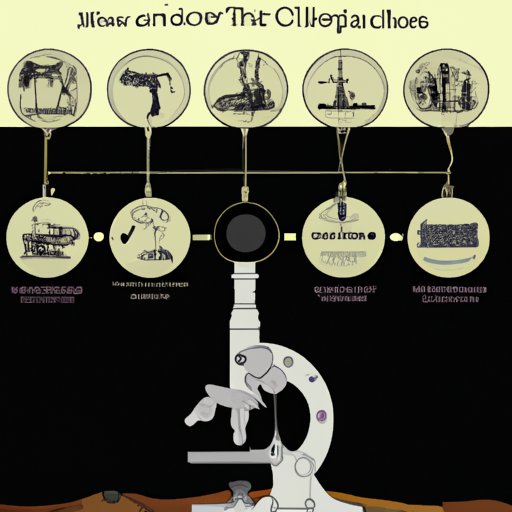Introduction
The microscope is an essential tool for scientists and researchers across the world. From medical research to astronomy, the microscope has helped us to uncover a vast array of knowledge about our universe. But what year was the microscope invented? This article will explore this question by tracing the historical development of the microscope and examining the different theories surrounding its invention.
A Historical Overview of the Invention of the Microscope
The earliest records of the microscope date back to the late 16th century. The first known use of a microscope was in 1590 when two Dutch spectacle makers, Zacharias Janssen and his father Hans, developed a device that used two lenses to magnify objects. However, the invention of the microscope as we know it today is largely attributed to the Dutch scientist Antonie van Leeuwenhoek. In 1674, he constructed a single-lens microscope that could magnify objects up to 270 times their original size.
The invention of the microscope revolutionized the scientific community. For the first time, scientists were able to observe objects at a level of detail never seen before. This enabled them to make groundbreaking discoveries in fields such as biology, chemistry, and medicine. It also paved the way for new technologies, such as the electron microscope, which allowed researchers to observe even smaller objects.

Uncovering the Mystery of Who Invented the Microscope
While van Leeuwenhoek is largely credited with inventing the microscope, there are other theories surrounding who first developed the device. For example, some historians believe that the Italian polymath Galileo Galilei was the first to create a rudimentary version of the microscope in 1609. Others have suggested that the English scientist Robert Hooke was the first to make use of the microscope for scientific purposes in 1665.
These theories have been debated for centuries, but the truth is that no one knows for sure who invented the microscope. What is certain, however, is that the microscope has had a profound impact on science and technology.

The Role of the Microscope in Modern Scientific Study
Today, the microscope is used to study objects that are too small to be seen with the naked eye. Different types of microscopes, such as light microscopes, electron microscopes, and scanning probe microscopes, are used to observe and analyze a variety of materials, from cells to proteins. These microscopes allow scientists to make groundbreaking discoveries in fields such as genetics, nanotechnology, and material science.
In addition to its scientific applications, the microscope is also used in industry and manufacturing. For example, microscopes are used to inspect components for defects or to measure the dimensions of an object. They can also be used to observe the structure of materials, such as metals or ceramics, at a microscopic level.

Exploring the Timeline of When the Microscope Was Invented
The exact date of when the microscope was invented is unclear. While van Leeuwenhoek is widely credited with developing the first practical microscope in the 17th century, there is evidence that suggests the device may have been invented earlier. For example, the Italian polymath Galileo Galilei is believed to have created a rudimentary version of the microscope in 1609.
In addition to van Leeuwenhoek and Galilei, there were several other inventors who contributed to the development of the microscope. For example, the English scientist Robert Hooke is credited with using the microscope to make scientific observations in 1665. And in 1673, the Dutch scientist Christiaan Huygens designed a compound microscope, which combined two lenses to produce more powerful magnification.
Conclusion
The invention of the microscope has changed the way scientists conduct research and has enabled us to learn more about our universe than ever before. While it is uncertain who exactly invented the microscope, it is clear that the device has had a profound impact on science and technology. By exploring the timeline of when the microscope was invented, we can gain a better understanding of how it has evolved over the centuries.
(Note: Is this article not meeting your expectations? Do you have knowledge or insights to share? Unlock new opportunities and expand your reach by joining our authors team. Click Registration to join us and share your expertise with our readers.)
